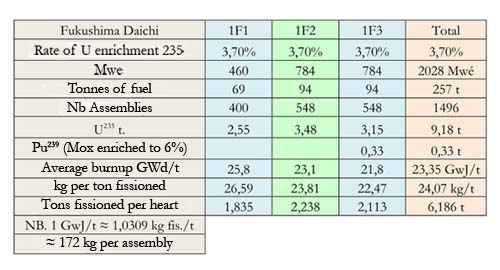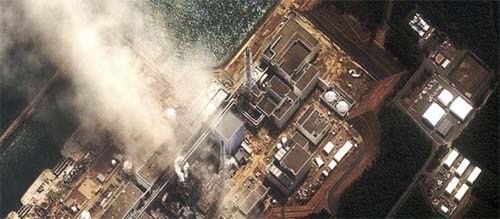SAN FRANCISCO—Dr. Paolo Scampa, PhD, a well-known physicist in the European Union, has prepared a radioactive inventory of Fukushima Daiichi’s destroyed nuclear power plants 500 days after the meltdown of three disemboweled, mangled reactors.
The violent extinction level event occurred Mar 11, 2011. The deadly meltdown and dispersion of radioactive fuel throughout the world is ongoing to this day.
Because of the nature of long-lived and short-lived radioactivity, this summation of the radioactive Fukushima inventory is valid for many years. Dr. Scampa’s inventory is current as of Friday, June 29, 2012.
There are 1,946 radioactive products produced by nuclear weapons and atomic reactors, according to the Oak Ridge Nuclear Weapons Lab in America.
Fifty-five are considered to be long-lived; 898 are considered to be short-lived but last more than eight days. These nine hundred fifty-three radioactive isotopes are included in this analysis.
Nine hundred ninety-three (993) radioactive isotopes are considered dangerous and undergo radioactive decay within eight days; they are not included in this analysis.
Dr Scampa’s article is available to French speakers and all who wish to review the original French here.
I am solely responsible for any and all translation errors.
* * *
FRIDAY, JUNE 29, 2012
New inventory of reactor fuels 1, 2 & 3 of Fukushima
. . . by Dr. Paolo Scampa, AIPRI
(European Union)—In light of the recent facts so testified of the medium rates of effective combustion (23.35 GwJ/t) and of enrichment (3.7%) of the reactors 1, 2, and 3 of Fukushima Daichi advanced by a team of Japanese nuclear physicists, after numerous rough sketches of reduced numbers, AIPRI is finally in condition to present a realistic inventory of fission and activation products of the 257 tonnes (1) of fuel in the three eviscerated reactors at Fukushima Daiichi. (Radionuclide Release to Stagnant Water in Fukushima-1 Nuclear Power Plant. See below.)
Alas, contrary to our reductive conjectures from the past there are many more fission products and long-lasting activation products than we had all too optimistically imagined.
It is not 3.7 tonnes, but instead more than 6 tonnes of material that was subject to fission; it is no longer 2.1 tonnes, but 2.8 tonnes that have been activated into heavier radioactive elements. To our great regret, the potential content of long-lasting radiotoxicity is well above our original estimates.
[See spreadsheet No 1, the first of six.]
 The three melted reactors combined in Fukushima Daichi contained 257 tons of nuclear fuel enriched to 3.7% Uranium 235 and divided into 1,496 assemblies, each about 172 kg.
The three melted reactors combined in Fukushima Daichi contained 257 tons of nuclear fuel enriched to 3.7% Uranium 235 and divided into 1,496 assemblies, each about 172 kg.
Reactor No. 3 also housed 32 MOX assemblies, reportedly enriched to 6% or 330 kg of Pu239.
In addition, the storage pools of these reactors have at least 239 tonnes of fuel residing there for who knows how long (1,390 assemblies) and 31 tonnes of fresh fuel (180 assemblies).
At a total electrical capacity of 2,028 MWE (2), these reactors fissioning together, had a total fission of around 1.847E20 (3) atoms per second (≈ 0.0726 g) that is to say, 6.27 kg of material per day.
The activity attained by a radioactive element in a fuel is found to be that number of fissioned atoms per second with a constant * the total product of fission of the element being considered * e(t -λ) the probability factor 1-e(t—λ) is 1 in the case of perfectly balanced elements. NB. t is the time spent in the reactor.
The day of the earthquake their fuel was consumed according to the article cited at an average of 23.35 GWd/t at a rate of 24.07 kg/t for a total of 6.186 tonnes of fuel fissioned.
The atoms of U235 only comprise a fraction of the fissioned atoms of these 6.186 tonnes. This led to the probable fission of around 3.46 tonnes of U235 (56%), 1.86 tonnes of Pu239 (30%), 0.49 tonnes of U238 (8%) and 0.37 tonnes of Pu241 (6%).
At the time of the accident, there remained around 3.14 tonnes of fission products of the 6.19 tonnes produced over the course of time.
This fuel as well harbored around another 2.84 tonnes of residual activation products (32 assemblies of Pu239 MOX fuel are not included here) over the 5.01 tonnes of activation products produced over time. At the moment of the emergency stop, about 1.1% of the fuel was comprised of activation products.
Overall, 9 tonnes of fuel was subjected to atomic fission or activation transformation occasioning a prodigious explosion of radioactivity and radiotoxicity which over time, is several times the amount needed to kill by internal contamination the whole human race.
K. Nishihara, et al., “Radionuclide release to Stagnant Water in Fukushima-1 Nuclear Power Plant,” Trans. At. Energy Soc, Japan, Vol 11 (1), pp 13—19, 2012 (in Japanese).
The atomic factory disemboweled and fanned out
For such a burn up of 23.35 GWd/t and such a mass as 257 tonnes of UOX the total radiological activity at shutdown is on the order of 29.14 billion Curies [Ci,] that is 1.078E21(4) Bq of which 4.97 billion Ci (1.84E20 Bq) is released as gas.
At the shutdown the elements of less than one year half life, hold 99.33% of the radioactive activity and 65.32% of the radiotoxicity. The half-life elements of more than a year represent only 0.67% of the radioactivity but 34.68% of the radiotoxicity.
The most remarkable of the volatile elements (elements of which the boiling point is inferior to 1,500 degrees Centigrade and escape above all the first coriums). 37,921 PBq; 1 billion Ci; 18 billion potential inhaled lethal doses.
The official report of the Japanese government to the IAEA [International Atomic Energy Association] contains a hypothesis that the emanations of nuclear fuel from Fukushima Daiichi are equivalent to the ones observed at Chernobyl.
We can see by comparing the subsets of figures below that the radioactive particle emission through the air from Fukushima is not only 3.7 times higher than Chernobyl; but, more importantly, 28.3 times more radiotoxic with every breath you take.
Sources and Notes.
“New inventory of reactor fuels 1, 2, & 3 of Fukushima,” by Dr Paolo Scampa, Jun 29, 2012, AIPRI Blog, http://aipri.blogspot.it/2012/06/nouvel-inventaire-des-combustibles-des.html http://tinyurl.com/7j8npql
(1) “Tonnes” in the singular is defined as 1,000 kg. each and 2,200 lbs each.
(2) A single MWE is defined as One Million Watts of Electricity.
(3) The decimal equivalent of 1.847E20 is 184,700,000,000,000,000,000 atoms per second fissioned. The number is spoken as: one hundred eighty-four quintillion, seven hundred quadrillion.
(4) The decimal equivalent of 1.078E21 is 1,078,000,000,000,000,000,000 Bq. The number is spoken as: one sextillion, seventy-eight quintillion. One Curie is equal to 37 Billion Becquerels per second. One Becquerel is one atomic disintegration per second.
Dr Scampa’s first included spreadsheet from the AIPRI article. There are six total.
Spreadsheet No 1: AIPRI, Jun 2012 Spreadsheet No 2, 3, 4, 5 and 6:
Spreadsheet No 2, 3, 4, 5 and 6:
Go to Dr Scampa’s original AIPRI Blog for the detailed spreadsheets Nos. 2, 3, 4, 5 and 6. They are all here: http://aipri.blogspot.it/2012/06/nouvel-inventaire-des-combustibles-des.html or http://tinyurl.com/7j8npql
Copyright © 2012 Bob Nichols, All Rights Reserved. Republishing allowed with all Sources and Notes included.






Our Farallon Project has data on two inventions to contain the Fukishima radwaste. The first is Seacrete, using seawater and solar energy, to safely encapsulate any of their radioactive material inplace. The second is Transmutation, which changes any radwaste into radioactive Iodine only active for 30 days. Then into safely non-nuclear material. I’ve been a radwaste expert since the 70′s. RSVP for technical data on above.
Pingback: Prepper Podcast Radio Network News